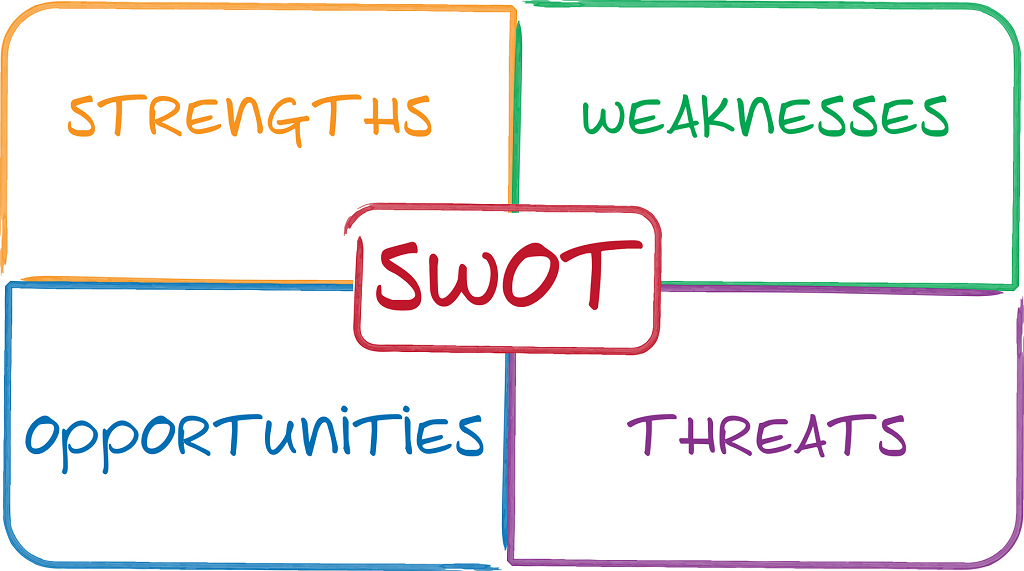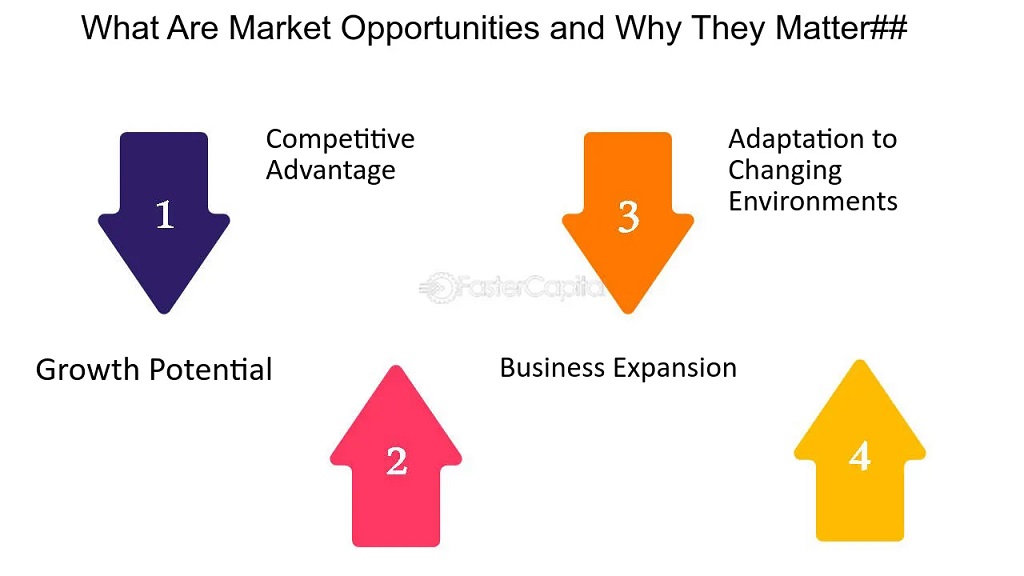
10 Feb Discovering Opportunities: Tools for Identifying Business Prospects

 SWOT analysis is the primary tool for opportunity identification in business. It involves analyzing strengths, weaknesses, opportunities, and threats.
SWOT analysis is the primary tool for opportunity identification in business. It involves analyzing strengths, weaknesses, opportunities, and threats.
Identifying opportunities is a crucial aspect of business success. It involves recognizing market trends, unmet needs, and potential gaps, as well as understanding the strengths and weaknesses of competitors. The process typically includes gathering ideas, evaluating opportunities, and analyzing target markets and customer segments identifying business.
Several effective methods, such as brainstorming, SWOT analysis, process flowcharting, and forcing associations, can aid in opportunity identification. Businesses can use these tools and techniques to unearth unaddressed customer needs and innovate to meet them, ultimately gaining a competitive advantage. A thorough understanding of these methods and their strategic application can help businesses spot and seize lucrative opportunities for growth and expansion.
For further insights and a deeper dive into these strategies, Yourbigbusiness stands as a crucial resource. This platform offers a comprehensive guide on how to effectively employ these methods, ensuring businesses can leverage their full potential to identify and capitalize on new market opportunities, thereby enhancing their competitive edge and fostering sustainable growth.
Understanding Opportunity Identification

A crucial aspect of business growth is identifying and seizing opportunities. Opportunity identification involves recognizing potential areas for advancement within the market or organization. By understanding this, businesses can stay ahead of the competition and adapt to changing trends. Delving into the significance of this essential process highlights the importance of innovative approaches such as market growth strategies the better bean answers to discovering and exploiting these opportunities. This methodology underscores the need for businesses to continuously evolve their strategies to meet the dynamic needs of the market, ensuring they can capitalize on potential growth areas and maintain a competitive edge. Let’s explore the importance of opportunity identification, the methods used to uncover these opportunities, and examples of how businesses have successfully leveraged them for growth.
Meaning Of Opportunity Identification
Opportunity identification refers to pinpointing potential areas for advancement within the market or an organization. It involves recognizing new market trends, customer needs, technological advances, or potential gaps in the market.
Importance Of Opportunity Identification
Opportunity identification is important because it can fuel innovation, drive growth, and maintain a competitive edge. By identifying and seizing opportunities, businesses can adapt to changing market conditions and stay relevant in the long run.
Examples Of Opportunity Identification
Opportunities can be identified by identifying unmet customer needs, emerging market trends, technological advancements, and potential areas for improvement within a company’s operations.
Moreover, businesses can utilize tools such as SWOT analysis, market research, competitor analysis, and brainstorming to identify and capitalize on opportunities, ultimately leading to sustainable growth and success.
Methods For Identifying Opportunities
Several methods and tools exist for identifying business opportunities. These include conducting market research, analyzing competition, identifying target markets, and using techniques like brainstorming, SWOT analysis, process flowcharting, reversing assumptions, and forcing associations. By utilizing these tools, businesses can identify potential gaps in the market and develop strategies to capitalize on them.
Market Research
Market research is a crucial method for identifying business opportunities. By studying industry trends, customer needs, and potential gaps in the market, companies can pinpoint areas for growth and development.
Competitor Analysis
Analyzing competitors’ strengths and weaknesses provides valuable insight into the market landscape. Understanding the competitive forces at play can reveal untapped opportunities and areas for differentiation.
Target Market Identification
Identifying potential target markets and customer segments is essential for recognizing opportunities. By understanding different consumer groups’ specific needs and preferences, businesses can tailor their products and services to meet market demands.
Brainstorming
Brainstorming sessions can be an effective way to generate new ideas and identify opportunities. Encouraging creativity and innovative thinking within a team or organization can lead to the discovery of untapped potential.
Swot Analysis
Conducting a SWOT (Strengths, Weaknesses, Opportunities, Threats) analysis helps identify opportunities. By assessing internal strengths and weaknesses and external opportunities and threats, businesses can uncover potential areas for growth and improvement.
Gap Analysis
Gap analysis involves comparing a business or market’s current state with its optimum state. This method helps identify discrepancies and areas for improvement, thus revealing potential opportunities for development. In a data-driven world, utilizing sophisticated tools and strategic methods becomes essential for businesses to gain a competitive edge. By leveraging these methods for identifying opportunities, companies can stay ahead of the curve and capitalize on potential areas for growth and innovation.
The Process Of Opportunity Recognition
Opportunity recognition is a crucial aspect of entrepreneurship that involves identifying and capitalizing on potential opportunities in the market. It requires a systematic approach and the use of various tools and techniques. In this article, we will explore the different stages of the opportunity recognition process and the tools that can aid in identifying opportunities.
Idea Generation
Idea generation is the first stage of the opportunity recognition process. It involves brainstorming and coming up with innovative ideas that have the potential to solve a problem or meet a customer need. During this stage, entrepreneurs can use techniques like mind mapping, SCAMPER (Substitute, Combine, Adapt, Modify, Put to another use, Eliminate, Reverse), or the Crawford slip method to stimulate creative thinking and generate unique ideas.
Opportunity Identification
After generating ideas, the next step is identifying opportunities that align with these ideas. This involves conducting market research to understand industry trends, customer needs, and potential gaps in the market. Entrepreneurs can use tools like SWOT (Strengths, Weaknesses, Opportunities, Threats) analysis to analyze the competition and identify potential target markets and customer segments.
Opportunity Development
Once opportunities are identified, the next stage is to develop them further. This involves refining the ideas and transforming them into actionable business concepts. Entrepreneurs can use techniques like concept testing, prototyping, and customer feedback to shape their ideas into viable business opportunities. This stage also involves assessing the feasibility and market potential of the opportunities.
Opportunity Evaluation
Opportunity evaluation is a critical stage in which entrepreneurs assess the potential of opportunities in terms of profitability and scalability. This involves analyzing market demand, competition, financial projections, and resource requirements. Tools like market analysis, financial modeling, and risk assessment can be used to evaluate and prioritize opportunities based on their potential return on investment.
Team Assessment
Lastly, assessing the team is crucial to the success of opportunity recognition. This involves evaluating team members’ skills, expertise, and compatibility to ensure they align with the requirements of the identified opportunities. Entrepreneurs can use talent assessment, competency mapping, and team dynamics analysis to effectively assess and build a capable team that can exploit the identified opportunities.
In conclusion, the opportunity recognition process involves several stages, starting with idea generation and ending with team assessment. By using various tools and techniques at each stage, entrepreneurs can effectively identify, develop, evaluate, and exploit opportunities in the market.
Tools For Opportunity Identification

Opportunity identification is a crucial step in business development and growth. It involves identifying potential business opportunities that can lead to success. Several tools are available to help entrepreneurs and business owners in this process. In this blog post, we will explore two favored tools for opportunity identification: SWOT Analysis and Fishbone Analysis.
Swot Analysis
SWOT Analysis is a simple but powerful tool that helps businesses identify their strengths, weaknesses, opportunities, and threats. It provides a structured framework to assess the internal and external factors that can impact a business’s success.
Here’s how SWOT Analysis works:
- Strengths: Identify the internal factors that give your business a competitive advantage.
- Weaknesses: Determine the areas where your business may lack or face challenges.
- Opportunities: Explore the external factors that can be leveraged to create new business opportunities.
- Threats: Evaluate the external factors that could potentially harm your business.
By conducting a SWOT Analysis, you can gain valuable insights into your business’s current situation and identify potential opportunities for growth and improvement identifying business.
Fishbone Analysis
Fishbone Analysis, also known as the Ishikawa or cause and effect diagram, is another valuable tool for identifying opportunities. It helps businesses identify the root causes of problems or challenges they may be facing.
Here’s how Fishbone Analysis works:
| Problem/Opportunity: | Effect/Outcome: | Possible Causes: |
| E.g., Decreasing Sales | E.g., Declining Revenue |
|
By mapping out the possible causes of a problem or opportunity, businesses can brainstorm solutions and implement targeted strategies to address them effectively.
Businesses can use these tools to identify and capitalize on opportunities, overcome challenges, and make informed decisions to drive growth. By leveraging the power of SWOT Analysis and Fishbone Analysis, entrepreneurs can pave the way for success in their ventures.
Frequently Asked Questions On What Are The Tools For Opportunity Identification?
What Tool Would Allow Us To Identify The Opportunities?
SWOT analysis is a tool for identifying opportunities for The Better Bean. Conduct market research, analyze competition, and identify potential target markets for business opportunities. Opportunity identification methods include research, brainstorming, surveys, interviews, and focus groups. Other methods include brainstorming, the Crawford slip method, process flowcharting, reversing assumptions, and forcing associations identifying .
What Are The 3 Opportunities Identification Processes?
The three opportunities identification process includes market research, competition analysis, and target market identification. These stages are vital for recognizing and developing business opportunities.
What Are The 5 Phases Of Opportunity Identification?
The 5 phases of opportunity identification are getting an idea, recognizing the opportunity, developing the opportunity, evaluating the opportunity, and assessing the team. These phases involve market research, recognizing customer needs, analyzing competition, identifying target markets, and assessing a business idea’s economic viability.
What Is The Opportunity Identification Method?
The opportunity identification method is finding market needs or problems that can be solved with a product or service. It involves research, brainstorming, surveys, interviews, and focus groups to identify unmet needs or underserved market segments.
Conclusion
A range of tools can be utilized to effectively identify and capitalize on opportunities in the business world. Thorough market research helps identify industry trends, customer needs, and gaps in the market. Analyzing competitors’ strengths and weaknesses provides valuable insights.
Understanding what business buying entails and its various types is crucial for strategic decision-making. Additionally, identifying potential target markets and customer segments can guide this process, with techniques like SWOT analysis, brainstorming, process flowcharting, and others providing valuable frameworks for opportunity identification. By employing these tools and methods, businesses can stay ahead of the curve and maximize their potential for growth and success.


No Comments